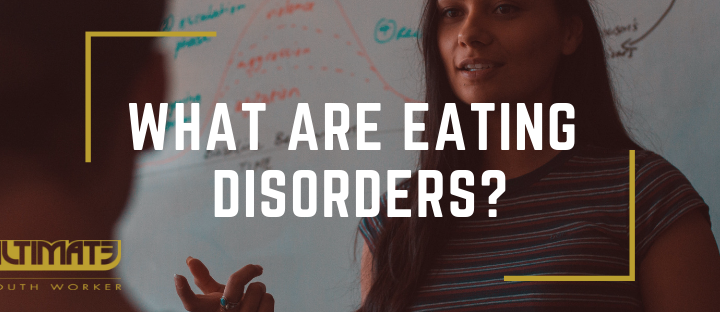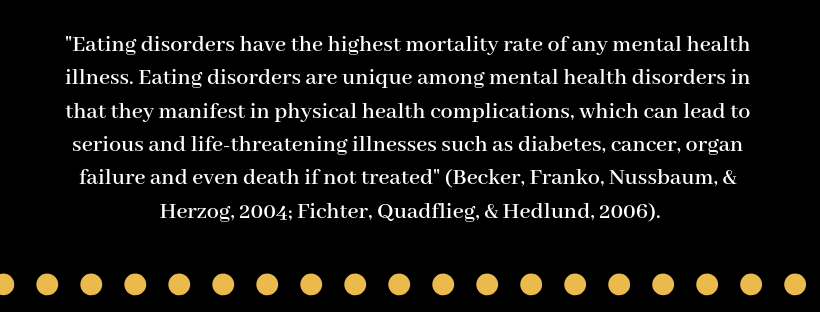Adolescence can be a difficult time for young people. It is a period of intense change both physically and emotionally, partnered with stress, confusion and anxiety. Young people are extremely vulnerable during this time and can be susceptible to experiencing mental health issues such as depression, anxiety, substance use problems and eating disorders.
Have you ever eaten greasy fast food and regretted it after?
Have you ever felt like you’ve over eaten and felt sick after?
Have you ever gone over the day in your mind and thought about everything you’ve eaten?
These are normal thoughts that all of us experience. But imagine thinking it over and over, all day long, obsessing over every calorie, and feeling constant guilt and regret. This is what someone with an eating disorder may experience, each and every day, sometimes for many years.
Young people are particularly at risk of experiencing an eating disorder. Unfortunately, social media plays a huge part in this. When we were teenagers, the most exposure we had to celebrities and models was in a teen magazine that we bought from the newsagent, or on the occasional movie or television show. But these days, young people are exposed to images every day, literally at the tips of their fingers. Instagram, Facebook and the internet show constant photos and videos of people you know or don’t know, which unfortunately causes feelings of insecurity and inadequateness in young people in terms of how they think they should look.
What is an eating disorder?
“An eating disorder is a serious mental illness, characterised by eating, exercise and body weight or shape becoming an unhealthy preoccupation of someone’s life. It’s estimated that one million Australians have an eating disorder, and this number is increasing. Eating disorders are not a lifestyle choice, a diet gone wrong or a cry for attention. Eating disorders can take many different forms and interfere with a person’s day to day life.”
There are many different types of eating disorders and these have been categorised in the Diagnostic and Statistical Manual of Mental Disorders (DSM), edition 5, which was published in 2013. The most common types are:
- Anorexia Nervosa; significant weight loss due to the persistent restriction of food/energy intake, intense fear of gaining weight and disturbance in self-perceived weight or shape. People with anorexia often refuse to maintain weight at or above a normal weight for their height/body shape/age/activity level.
- Bulimia Nervosa; characterised by a distorted body image and an obsessive desire to lose weight, in which bouts of extreme overeating are followed by fasting, self-induced vomiting, purging, excessive exercise or use of laxatives/diet pills.
- Binge Eating Disorder; regular episodes of binge eating accompanied by feelings of loss of control, and in many cases; guilt, embarrassment and disgust. Unlike those with bulimia nervosa, a person with binge eating disorder will not use compensatory behaviours, such as self-induced vomiting or over-exercising after binge eating. Many people with binge eating disorder are overweight or obese.
- Others include: Pica, Rumination Disorder, Avoidant/Restrictive Food Intake Disorder (ARFID), Other Specified Feeding or Eating Disorder (OSFED) and Unspecified Feeding or Eating Disorder (UFED).
You can read more about each of the different eating disorders here.
Why are young people more at risk of experiencing an eating disorder?
Whilst eating disorders can affect people of all ages, socio-economic groups and genders, adolescence is the most common stage of onset of anorexia nervosa, bulimia nervosa and disordered eating. Although eating disorders can be caused due to a number of factors (personal, environmental, psychological, biological and social), it appears that youth are the most at-risk group of developing an eating disorder, and this can be due to many factors.
As mentioned at the start of this blog post, adolescence can be a tough time for young people. So many changes, both physically and socially, in addition to hormone and brain changes that in turn can affect a young person both emotionally and psychologically. The physical changes within adolescence can cause a young person to feel self-conscious, experience low self-esteem and compare themselves to peers (as well as others that they see through social media). In addition to starting high school, making new friends and trying to “fit in”, young people may also start to feel attraction to others of the opposite or same sex. All of these changes, in addition to their body literally changing shape, as well as other physical changes, place young people at higher risk of developing an eating disorder. Furthermore, eating disorders can be a coping mechanism of young people to try and control something in their life, as they may feel helpless in other aspects of their lives where there has been dramatic change. Who do you work with that has experienced dramatic change recently or even consistently? It’s commonplace with the young people we work with.
Click here for further statistical information about eating disorders.
Are there other risk factors for eating disorders?
There is no single cause of an eating disorder, but other risk factors for eating disorders include low self-esteem, feelings of inadequacy, depression or anxiety, pressure from family for perfectionism or high achievement, difficulty expressing emotions, ineffective coping strategies, impulsive or obsessive behaviours, conflict in the home or another life crisis, peer pressure, media representations, critical comments about one’s appearance, bullying, physical or sexual abuse, predisposition to an imbalance in serotonin, dieting, history of family obesity and so on.
What are the physical signs of an eating disorder?
The physical signs of an eating disorder might include fluctuation in weight or significant weight loss, loss of menstrual periods (women), fatigue, dizziness, changes in skin/hair/nails, sensitivity to the cold, swelling around the cheeks or jaw, damage to teeth, bowel problems (e.g. constipation) and dehydration.
What are the psychological signs of an eating disorder?
The psychological signs of an eating disorder can include preoccupation with body weight and/or appearance, increased mood changes, irritability, reduced concentration, memory loss, anxiety around meal times, sensitivity to criticism, negative and distorted body image, guilt, self-loathing, obsessive behaviours, rigid thinking (e.g. labelling foods as “good” or “bad”), difficulty with relationships, suicidal thoughts or behaviour and drug and alcohol misuse.
What are the behavioural signs of an eating disorder?
The behavioural signs of an eating disorder may include dieting or overeating, obsessive rituals (e.g. only eating certain foods on certain days), making frequent excuses not to eat, not eating around others, hoarding food, trips to the bathroom after meals and so on.
Can you think of a young person you’ve worked with that displayed psychological, physical or behavioural signs of an eating disorder? What symptoms did they display, and were you able to intervene/assist them?
Importance of early intervention.
It is extremely important that early intervention is achieved in adolescents where an eating disorder is present. This is because during adolescence, not only does a young person’s physical body change, grow and develop, but so does their brain. If this growth and development is interrupted and left untreated, it can cause severe physical damage (chronic illness), further mental health issues and even death.
It’s important to promote eating disorder and body image dissatisfaction prevention programs in schools and within local communities. For instance:
- Encouraging physical activity in a healthy way, team sports, as well as how to cook nutritious meals are important elements that can be introduced to schools and support services where group work is provided.
- Anti-bullying programs can be effective in targeting behaviours that can cause eating disorders to develop amongst adolescents in school.
- Gender equity programs that challenge stereotypes of how young people think they should “look”, as well as dissecting social media and brand representations of men and women.
How do we treat eating disorders?
A multi-disciplinary approach to treatment of eating disorders is ideal as there are both physical and psychological aspects that need to be addressed to target the underlying causes and promote long term recovery. There are many different treatment options and settings for eating disorders and these can depend on the type of eating disorder as well as the perceived severity of the problem. Some treatment options include:
- Physical health management / hospitalisation
- Mental health management
- Nutritional counselling and advice
- Psychotherapy
- Cognitive behavioural therapy
- Group therapy
- Family based therapy
- Anti-depressants
- Support groups and so on.
For more information on treatment options, visit Eating Disorders Victoria.
Further resources:
https://www.kidsmatter.edu.au/sites/default/files/public/EatingDisorderResourceSchools.pdf
https://thebutterflyfoundation.org.au/assets/Uploads/A5-Ed-brox-online.pdf
https://thebutterflyfoundation.org.au/our-services/education/
https://thebutterflyfoundation.org.au/about-us/information-and-resources/



